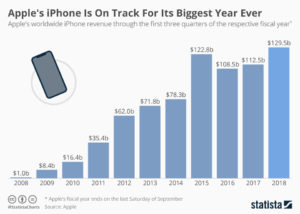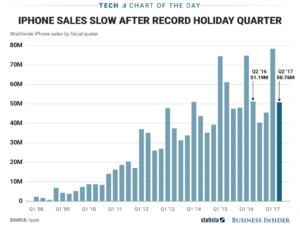It’s not a coincidence that when I Googled, “what date does the new” the sentence was completed with the top option, “iPhone come out?” in my search bar. Since 2007, when Apple released the first iPhone, the pressure to stay up to date within the entrepreneurial cultural push became a reality. Though only less than 3 years ago I purchased my iPhone 6s, I feel out of date when I become the only person at a table without a 10 or an X.
Apple releases their new products typically every September, which means that individuals either save money in preparation to annually invest in Apple or like my family, we wait for the new iPhone to come out to buy the older versions because when new products release, previous product prices decrease. But how are the prices of an iPhone, indicators of our economy and why are these pieces of technology so vital to our lives?
In 2008 and 2009 when the United States was in a recession, Apple released their first iPhone and reported a strong first-quarter profit which shocking in a time of financial turmoil.

Source: https://www.statista.com/chart/14948/apple-iphone-revenue/
“Where many of the other consumer-facing companies are missing their expectations and seeing their revenues decline, Apple continues to see growth,” said David Bailey, an analyst at Goldman Sachs in 2008. “It [Apply] is gaining market share in every category, and given the premium price of their products, that is a significant achievement.” Though Apple had been preparing for their iPhone launch for years and could not have predicted the state of the economy at their iPhone launch date, they still took the risk and had the confidence to release a luxury product to the market. But, the opportunity for people to invest back into the economy by purchasing technology and supporting innovation and entrepreneurship to drive growth, is what may have led Apple to be the biggest corporation and most popularly used technology worldwide.
During the recession holiday season, Apple sold 4.36 million iPhone 3Gs, compared to today where they sold 29 million iPhone units in their fourth quarter in 2018. Which is a substantially higher revenue than all of Apple’s competitors in the smartphone market in the United States.
Source:https://www.businessinsider.com/apple-iphone-sales-history-chart-2017-5?r=UK&IR=T
It is important to take into consideration a companies market size across various countries over a period of time to indicate their unanimous success. Though Apple sales have hit an all-time high this year in the United States, according to Business Insider, Analysts at UBS expect iPhone sales to continue to drop for Chinese consumers. Chinese consumers have flocked to more affordable domestic brands over the past three years, such as devices from local brands like Xiaomi, Huawei, Oppo, and Vivo. Which resulted in Apple investing $500 million this year in research of the Chinese market.
Source:https://www.businessinsider.com/apple-iphone-sales-region-china-chart-2017-3
According to Forbes, Apple continues to dominate the smartphone profit pool by capturing 51% of the segment’s revenue and I will continue to feel societal pressure to upgrade my iPhone 6S to an X. But, because Apple will systematically reduce their prices so anyone who cannot afford to drop $999 on an X, can continue to invest and purchase their products, and I will most likely be purchasing a new phone as well.
Sources:
https://www.statista.com/chart/7800/apples-quarterly-iphone-sales/
